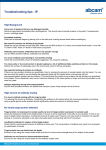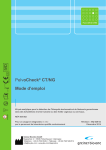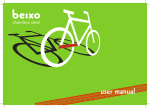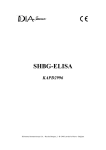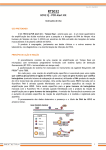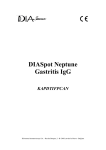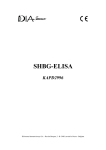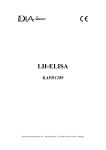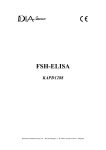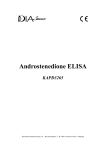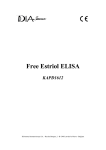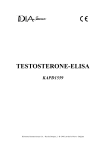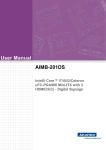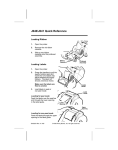Download Anti-HCV Elisa - DIAsource Immunoassays
Transcript
Anti-HCV Elisa 4.0 KAPG4NAE3 DIAsource ImmunoAssays S.A. - Rue du Bosquet, 2 - B-1348 Louvain-la-Neuve - Belgium : 110711/3 Anti-HCV Elisa V 4.0. For in-vitro qualitative detection of Antibody to Hepatitis C virus (antiHCV) in human serum or plasma en KAPG4NAE3 IN VITRO DIAGNOSTIC USE DIAsource ImmunoAssays SA - Rue du Bosquet 2, B-1348 Louvain-la-Neuve, Belgium Tel: +32 10 84 99 11 - Fax : +32 10 84 99 90 1) INTENDED USE Anti-HCV Elisa V 4.0 is a forth generation enzyme immunoassay diagnostic kit for in-vitro qualitative detection of Antibody to Hepatitis C virus (anti-HCV) in human serum or plasma. 2) DESIGN THEORY/ BRIEF DESCRIPTION OF THE PRODUCT Anti-HCV Elisa V 4.0 adopts the "direct sandwich principle" as the basis for the assay to detect antibodies to Hepatitis C virus (anti-HCV). It is a forth generation enzyme immunoassay kit, which uses recombinant HCV antigens (Core, NS3 and NS5 antigens) for the detection of Antibody to Hepatitis C virus (anti-HCV) in human serum or plasma.*1-3 These antigens, which are reactive with the predominant antibodies of HCV, constitute the solid phase antigenic absorbent. When human serum or plasma is added to the well, the HCV antigens and Anti-HCV will form complexes on the wells if Anti-HCV is present in the specimen. The wells are washed to remove the unbound materials. The diluted HCV Ag•HRPO Conjugate is added to the well and results in the formation of (HCV) • (Anti-HCV) • (HCV Ag•HRPO) complex. After washing out the unbound conjugate, TMB substrate solution is added for color development. The intensity of color development is proportional to the amount of antibodies present in the specimen. The reaction processes are summarized as follows: A. Specimen (containing Anti-HCV): 1. Plate (HCV Antigens) + Specimen (containing Anti-HCV) → plate (HCV Antigen)•Anti-HCV 2. Wash to remove the unbound materials. 3. Plate (HCV Antigen) •Anti-HCV + HCV Ag•HRPO → Plate (HCV Antigen)•Anti-HCV•HCV Ag•HRPO complex 4. Wash to remove the unbound materials. 5. Plate (HCV Antigen) •Anti-HCV•HCV Ag•HRPO complex + TMB Solution → light blue to blue color 6. Light blue to blue color + Stop Solution → light yellow to yellow color, measured at 450nm with a selected reference wavelength within 620 to 690nm*4 B. Specimen (without human Anti-HCV): 1. Plate (HCV Antigens) + Specimen (without Anti-HCV) → plate (HCV Antigen) 2. Wash to remove the unbound materials. 3. Plate (HCV Antigen) + HCV Ag•HRPO → plate (HCV Antigen)------ No complex will form 4. Wash to remove the unbound materials. 5. Plate (HCV Antigen) + TMB Solution (colorless) → colorless 6. colorless + Stop Solution → colorless, measured at 450nm with a selected reference wavelength within 620 to 690nm*4 3) DESCRIPTION OF PROVIDED MATERIALS & PRODUCT CODE SYSTEM ● Item 1 - 7 on the following reagent table should be refrigerated at +2 to +8°C. Washing Solution D (20X) and Stop Solution can be stored at +2 to +30°C. ITEMS Components (1) Description Qt. per 96 tests Microtiter plate coated with HCV antigens. 1 plate Contained HCV Ag•Peroxidase (Horseradish) in buffer with Bovine serum. Preservatives: 0.005 % Sodium azide and 0.05 % Enzyme stabilizer. 1bottle, 1.8 ml Inactivated human plasma positive for AntiHCV. Preservative: 0.099 % Sodium azide. 1 bottle, 2.0 ml Normal human plasma non-reactive for Antibody to HCV. Preservative: 0.099 % Hepatitis C Negative Sodium azide. Control 1 bottle, 3.0 ml HCV Antigens Plate Ag (2) HRP CONC Conc. HCV Ag•HRPO Conjugate CONTROL H (3) Anti-HCV Positive Control CONTROL (4) Catalogue Nr: KAPG4NAE3 L PI number : 1701265 Revision Nr : 110711/1 CONJ BUF (5) Conjugate Diluent CHROM TMB CONC (6) PB-buffer with Bovine serum and Tween-20. Preservatives: 0.005 % Sodium azide and 0.05 % Enzyme stabilizer 1bottle, 24 ml 3, 3’, 5, 5’-tetramethylbenzidine (TMB) in an organic base. 1 bottle, 12 ml Citric acid buffer with Urea Hydrogen Peroxidase 1 bottle, 12 ml Phosphate buffer with Tween-20. 1 bottle 110 ml Stop Solution 1 bottle 12 ml Chromogenic TMB concentrate (7) SUB BUF Substrate Buffer WASH SOLN CONC (8) Conc. Washing Solution D (20X) STOP (9) SOLN Stop Solution ● OTHER MATERIALS REQUIRED, BUT NOT PROVIDED ITEMS Components (1) 50µl, 100µl and 200µl, 1-ml micropipettes and tips are needed. (2) Water-bath at 37 +/- 1° or incubator at 37 +/- 1°. (3) Tubes for specimen dilution. (4) Plate washing equipment. ELISA Microwell Reader: (5) Dual wavelength 450nm with 620-690nm as reference wavelength*4, bandwidth 10nm. (6) Purified water: distilled or deionized water. Fully automatic EIA micro-plate analyzer is optional. User should validate the automatic EIA micro-plate analyzer in (7) combination with the kit. (8) Adhesive slip 4) INSTRUCTIONS FOR USE 4.1) Warnings 4.1.1) This reagent kit is for professional use only. 4.1.2) This reagent kit is for in vitro diagnosis only. 4.1.3) Bring all kit reagents and samples to room temperature (+20 to +30°C) and mix carefully before use. 4.1.4) Do not use reagent past its expiration date. 4.1.5) Do not interchange reagents between different lots. 4.1.6) Do not put pipette in mouth. 4.1.7) Do not smoke or eat in areas where specimens or reagents are handled. 4.1.8) All kit components and specimens should be regarded as potential hazards to health. It should be used and discarded according to your own laboratory’s safety procedures. Such safety procedures probably will include the wearing of protective gloves and avoiding the generation of aerosols. 4.1.9) Potential infectious specimens and non-acid containing spills or leakages should be wiped up thoroughly with 5% sodium hypochlorite or treated in accordance with your practice for potential bio-hazard control. 4.1.10) Prior to dispose the waste of used specimens and kit reagents as general waste; it should be treated in accordance with your treatment practice of potential bio-hazardous waste or treated as follows: Both liquid and solid waste should be autoclaved at 121°C for at least 30 minutes. Solid waste can also be incinerated. Non-acidic liquid waste can be treated with sodium hypochlorite diluted to a final concentration of 1%. Acidic liquid wastes must be neutralized before treatment with sodium hypochlorite as mentioned above and should stand for 30 minutes to obtain effective disinfection. 4.1.11) Stop Solution is an irritant to skin, eyes, respiratory tract and mucous membranes. Avoid contact of the Stop Solution with skin and mucous membranes. In case of contact, flush immediately with abundant amounts of water. In case of inhalation, find fresh air immediately and seek medical advice in case of pain. 4.1.12) Chromogenic TMB concentrate contains organic solvent, which is flammable. Chromogenic TMB concentrate contains dimethyl sulfoxide, an irritant to skin and mucous membranes. 4.1.13) Although all human sourced material are tested free from HBsAg and Anti-HIV and inactivated at 56°C for one hour, the reagent should still be handled as potential infectious material. *5 Catalogue Nr: KAPG4NAE3 PI number : 1701265 Revision Nr : 110711/1 4.2) Specimen Collection and Storage 4.2.1) Either serum or plasma can be used with this diagnostic kit. Whole blood specimens should be separated as soon as possible in order to avoid hemolysis. Any particulates (e.g. fibrin clots, erythrocytes) contained in the specimen should be removed prior to use. 4.2.2) Specimens must be stored at +2 to +8°C and avoided heat-inactivation to minimize deterioration. For long-term storage, they should be frozen below -20°C. Storage in self-defrosting freezer is not recommended. 4.2.3) Frozen specimens must be thoroughly thawed and mixed homogenously before test. 4.2.4) Avoid multiple freeze-thaw procedures. 4.2.5) Incompletely coagulated sera and microbial-contaminated specimens should not be used. 4.3) Reagents Storage 4.3.1) The kit must be stored at +2 to +8°C. Do not freeze. 4.3.2) Strips of the plate should be used within one month once the original aluminum foil bag is opened. The unused strips should be kept in the aluminum foil bag and taped the opening tightly. 4.3.3) Return reagents to +2 to +8°C immediately after use. 4.3.4) Washing Solution D (20X) Concentrate can be stored at room temperature to avoid crystallization, because the kits are stored and shipped at +2 to +8°C. If the crystal has been precipitated before use, warm up the solution in 37°C water bath till crystal dissolved. 4.4) Plate Washing Procedure 4.4.1) Preparation of washing solution: Dilute Washing Solution D (20X) Concentrate with distilled or de-ionized water to 1:20 dilution. Do not use tap water. 4.4.2) Plate washing: (a) For plate washer with overflow aspirating function: 6 cycles with at least 0.5ml washing buffer per well per cycle. Or (b) For plate washer without overflow aspirating function: 8 cycles with at least 0.35ml washing buffer per well per cycle. 4.4.3) Blot dry by inverting the plate and tapping firmly onto absorbent paper. Too much residual wash buffer will cause false results. WARNING Improper washing will cause false results. 4.5) Test Procedure 4.5.1) Bring all reagents and specimens to room temperature (+20 to 30°C) before assay. Adjust water bath or incubator to 37 ± 1 °C. 4.5.2) Preparation of Diluted Conjugate 1. Use only clean container to avoid contamination. 2. Prepare diluted conjugate by making 1:20 dilution of Conc. HCV Ag•HRPO conjugate with conjugate diluent, or following Conjugate Preparation Chart below. Swirl gently to mix thoroughly and avoid foaming. 3. Excess diluted conjugate solution should be discarded after use. Conjugate Preparation Chart: Volume of Conjugate Diluent Number of Wells used needed (ml) Volume of Conc. HCV Ag• HRPO conjugate needed (µl) 8 1 50 16 2 100 24 3 150 32 4 200 40 5 250 48 6 300 56 7 350 64 8 400 72 - 80 9 450 81 - 96 10 500 4.5.3) Reserve one well for blank. Do not add any specimen or specimen diluent into the well for blank. 4.5.4) Prepare the needed number of wells, including 1 well for Blank, 3 wells for Negative Control, 2 wells for Positive Control, and 1 well for each Specimen. 4.5.5) Sample input: 4.5.5.1) Add 100µl of Positive Control, Negative Control and specimen to each appropriate well of HCV Antigens Plate. 4.5.5.2) Mix well by tapping the plate gently. NOTE: Use a new pipette tip after each sampling to avoid cross-contamination. Catalogue Nr: KAPG4NAE3 PI number : 1701265 Revision Nr : 110711/1 4.5.6) Seal the Plate with an Adhesive Slip. 4.5.7) Incubate the plate in a 37 + 1 °C water bath or circulative incubator for 60 minutes. NOTE: Do not stack plates. 4.5.8) At the end of the incubation period, remove carefully the adhesive slip and discard. 4.5.9) Wash the plate according to section §4.4. Plate Washing Procedure. 4.5.10) Add 100µl of the Diluted Conjugate in each well, except the blank. 4.5.11) Seal the plate with an Adhesive Slip. 4.5.12) Incubate the Plate in a 37 + 1 °C water bath or circulative incubator for 30 minutes. 4.5.13) Repeat step 4.5.8) and 4.5.9) 4.5.14) Select one of the following methods for color development: A. Mix equal volumes of Chromogenic TMB concentrate and Substrate Buffer in a clean container immediately prior to use. Add 100µl of the mixture solution to each well including the blank. B. Add 50µl of Chromogenic TMB concentrate first, and then add 50µl of Substrate Buffer into each well including the blank. Carefully mix well. NOTE: Chromogenic TMB concentrate should be colorless to light blue; otherwise, it should be discarded. The mixture of Chromogenic TMB concentrate and Substrate Buffer should be used within 30 minutes after mix. The mixture should be avoided from intense light. 4.5.15) Seal the plate with an Adhesive Slip and incubate at 37 ± 1°C for 15 minutes. 4.5.16) Stop the reaction by adding 100µl of Stop Solution to each well including the blank. 4.5.17) Determine the absorbance of Controls and test specimens within 15 minutes, measured at 450nm with a selected reference wavelength within 620 to 690nm *4. Use the blank well to blank the spectrophotometer. NOTE: The color of the blank should be colorless to light yellowish; otherwise, the test results are invalid. Substrate blank : absorbance value must be less than 0.100 OD. 4.6) Calculation of Tested Data 4.6.1) Calculation of the NCx (Mean Absorbance of Negative Control). Example: Sample No. Absorbance 1 0.045 2 0.060 3 0.051 NCx = (0.045+0.060+0.051) / 3 = 0.052 NCx must be ≤ 0.200, otherwise the test is invalid. 4.6.2) Calculation of PCx (Mean Absorbance of Positive Control) Example: Sample No. Absorbance 1 1.510 2 1.826 PCx = (1.510 + 1.826) /2 = 1.668 PCx must be ≥ 0.600, otherwise the test is invalid. 4.6.3) Calculation of P-N Value P-N = PCx - NCx Example: P - N = 1.668 – 0.051 = 1.617 P - N Value must be ≥ 0.400, otherwise the test is invalid. 4.6.4) Calculation of the Cutoff Value Cutoff Value = NCx + 0.100 Example: Cutoff Value = 0.053+0.100 = 0.153 4.6.5) Calculate the cut-off index of the specimens Cutoff Index =Sample OD Value / Cutoff Value Example: Sample Value is 0.596 Cutoff Index = 0.596/0.153 = 3.895 4.6.6) Gray Zone: Cut-off index = 1.000 ~ 1.500 4.7) Quality Control of the Test Run Catalogue Nr: KAPG4NAE3 PI number : 1701265 Revision Nr : 110711/1 4.7.1) NCx must be ≤ 0.200, otherwise the test is invalid. 4.7.2) PCx must be ≥ 0.600, otherwise the test is invalid. 4.7.3) P-N Value must be ≥ 0.400, otherwise the test is invalid. NOTE: Negative Control: absorbance value must be less than or equal to 0.200 after subtracting the blank. 4.8) Result Interpretation 4.8.1) Specimens with CUTOFF INDEX < 1.000 are considered NON-REACTIVE by the criteria of DIAsource’s Anti-HCV Elisa V 4.0. 4.8.2) Specimens with CUTOFF INDEX ≥ 1.000 are considered as initially REACTIVE. They should be RETESTED in duplicate. If both CUTOFF INDEXES of the duplicate are GREATER than 1.500, the specimen is considered to be repeatedly REACTIVE for Anti-HCV by the criteria of DIAsource ImmunoAssays SA’s Anti-HCV Elisa V 4.0. Specimens repeatedly reactive in the Anti-HCV Elisa V 4.0 should be further tested by additional, more specific tests. 4.8.3) Initially reactive specimens, of which both CUTOFF INDEXES of the duplicate retest are LESS than 1.000, will be considered NON-REACTIVE for Anti-HCV. 4.8.4) If one of the two CUTOFF INDEXES of the duplicate is GREATER than 1.000 but LESS than 1.500, the specimen may be interpreted as QUESTIONABLE and this individual should be monitored in follow up samples, or additional more specific tests should be used. 4.8.5) If one of the CUTOFF INDEX of the duplicate is GREATER than 1.500 and the other one is LESS than 1.000, this indicates unusual experimental error. The test should be repeated again. 4.9) Troubleshooting If the result cannot be reproduced, please do your own preliminary troubleshooting by checking the possibilities listed below: 4.9.1) Improper washing procedure. 4.9.2) Contaminated with positive specimen. 4.9.3) Add wrong volume of sample, conjugate or substrates. 4.9.4) The well rim is contaminated with conjugate. 4.9.5) Improper specimen such as hemolyzed serum or plasma, specimen containing precipitate and specimen not being mixed well before use. 4.9.6) Wrong incubation time or temperature. 4.9.7) Obstructed or partial obstructed washer aspirate/dispense head and needles. 4.9.8) Insufficient aspiration. 4.10) Limitations and Interferences 4.10.1) This reagent kit is to be used for un-pooled human serum or plasma only. 4.10.2) The reagent kit has not been validated for use with cadaveric samples. 4.10.3) Specimens with very low level of Anti-HCV may not consistently repeat positive. In this case, it is recommended to test follow-up samples. 4.10.4) Anti-HCV negative result does not preclude the possibility of infection with HCV. 4.10.5) Non-repeatable false positive results may occur due to non-specific binding of the sample and conjugate to the wall of the well(s). 4.10.6) Potential Interfering Substances: there is no significant influence on Anti-HCV Elisa V 4.0. 4.11) Storage Conditions and Stability Kit/components Anti-HCV Elisa V 4.0 KIT Anti-HCV Positive Control Hepatis C Negative Control HCV Antigens Plate Conc. HCV Antigen•HRPO Conjugate Solution Storage condition +2 to +8°C +2 to +8°C +2 to +8°C +2 to +8°C +2 to +8°C State Stability Original 18 months Once open 1 month Original 18 months Once open 1 month Original 18 months Once open 1 month Original 18 months Once open 1 month Original 18 months Once open 1 month Conc. HCV Antigen•HRPO Conjugate Solution Room temp. Diluted 6 hours +2 to +8°C Diluted 2 days Conjugate Diluent +2 to +8°C Washing Solution D Concentrate (20X) Room temp. Catalogue Nr: KAPG4NAE3 PI number : 1701265 Original 18 months Once open 1 month Original 24 months Revision Nr : 110711/1 Room temp. 20X Diluted Washing Solution +2 to +8°C Chromogenic TMB concentrate +2 to +8°C Substrate Buffer +2 to +8°C TMB Substrate Solution Mixture Room temp. Stop Solution Room temp. Once open 1 month Diluted 2 days Diluted 1 week Original 24 months Once open 1 month Original 24 months Once open 1 month Mixture 6 hours Original 24 months Once open 1 month 4.12) Performance Characteristics 4.12.1) Analytical Specificity Potential Interfering Substances: There is no significant influence on Anti-HCV Elisa V 4.0. Potential Interfering Substances n tests n reactive Serum with interfering substances in fixed ratios (Triglycerides, hemoglobin, bilirubin, monoclonal IgG and 50 tests 0 IgM, and rheumatoid factor) Inhibition panels 14 negative samples 0 (EDTA, hemoglobin, triglyceride, bilirubin, and heparin) 14 positive samples 14 Anticoagulant Panels 25 negative samples 0 (Serum, EDTA plasma, heparinized plasma, and citrated 25 positive samples 25 plasma) Total 128 tested samples 39 n non-reactive 50 14 0 25 0 89 4.12.2) Clinical Specificity Clinical specificity = 5356/5369 = 99.8 % Potential Interfering Substances Blood donors Clinical / hospital specimens Potentially cross-reacting serum / plasma specimens Total n tests 5169 200 100 5369 n reactive 12 1 0 13 n non-reactive 5157 199 100 5356 Specificity 99.77 % 99.5 % 100 % 99.8 % 4.12.3) Analytical Sensitivity The analytical sensitivity of Anti-HCV Elisa V 4.0 assay is higher than the comparison test. Analytical Sensitivity PEI Reference Material Serial Dilution Positive Sample 1 30 30 ♦ Anti-HCV Elisa V 4.0 25 25 ■ Reference method ▲Cutoff ♦ Anti-HCV Elisa V 4.0 20 ■ Reference method Anti HCV (S/Co) Anti-HCV IgG (S/Co) 20 15 GBC NANBASE C-96 3.1 Ortho HCV 3.0 SAVe 15 Cut Off 10 10 5 5 0 GBC NANBASE C-96 3.1 ▲Cutoff Ortho HCV 3.0 SAVe Cut Off 0 0 2 4 6 8 10 12 14 16 18 20 0 2 Dilution Steps Catalogue Nr: KAPG4NAE3 4 6 8 10 12 14 16 18 20 Dilution Steps PI number : 1701265 Revision Nr : 110711/1 Serial Dilution Positive Sample 2 Serial Dilution of the Positive Control 25 35 ♦ Anti-HCV Elisa V 4.0 20 30 ■ Reference method ♦ Anti-HCV Elisa V 4.0 25 ■ Reference method 15 20 ▲Cutoff Anti HCV (S/Co) Anti-HCV (S/Co) ▲Cutoff GBC NANBASE C-96 3.1 Reihe2 15 Reihe3 10 GBC NANBASE C96 3.1 Cut Off Ortho HCV 3.0 SAVe 10 5 5 0 0 10 20 30 40 50 60 70 0 0 2 4 6 8 10 12 14 16 18 -5 20 Dilution Step Dilution Steps PeliCheck Anti-HCV Reference Panel 30 Anti-HCV (S/Co) 25 20 ♦ Anti-HCV Elisa V 4.0 ■ Reference method 15 ▲Cutoff 10 5 0 0 2 4 6 8 10 Dilution Step 4.12.4) Clinical Sensitivity 1. HCV infected individuals : The diagnostic sensitivity of the DIAsource ImmunoAssays SA Anti-HCV Elisa V 4.0 was determined to be 100 %. 421 of 421 positive samples including 20 samples per genotype for genotypes 1a – 4a and 5 samples for genotype 6 were tested and confirmed reactive for HCV antibodies. Total Sensitivity n=421 12,000 Ortho HCV 3.0 SAVe = 99.05 10,000 8,000 6,000 4,000 2,000 0,000 0,000 5,000 10,000 15,000 20,000 25,000 30,000 35,000 GBC NANBASE C-96 3.1 = 100% Anti-HCV Elisa V 4.0 = 100 % 2. Commercial seroconversion panels : Anti-HCV Elisa V 4.0 assay showed a higher seroconversion sensitivity in comparison with the chosen reference method which is CE-marked anti-HCV ELISA. The total number of tested samples from the 22 seroconversion panels amounted to 198. Sixty three (63) of these samples were tested reactive with Anti-HCV Elisa V 4.0 assay, whereas only 44 of these samples were found to be reactive with the reference method. 4.12.5) Precision Catalogue Nr: KAPG4NAE3 PI number : 1701265 Revision Nr : 110711/1 1. Intra-assay Reproducibility Positive Serum 1 Positive Serum 2 Positive Control Mean CV (%) Mean CV (%) Mean CV (%) Day 1 4.49 7.22 9.01 5.94 21.79 4.91 Day 2 4.16 13.06 8.54 9.41 21.44 4.23 Day 3 5.07 5.24 10,64 9,27 21,70 3,08 Mean 4.57 8.51 9.40 8.21 21.64 4.07 CUTOFF INDEX 2. Total Imprecision 4.13) Flow chart of the test procedure Add 100µl of Controls (3 X NC, 2 X PC) and 100µl per Specimen into wells. Reserve 1 well for blank. ↓ Incubate the plate at 37 ± 1°C for 60 minutes. ↓ Wash the plate. (Prepare diluted conjugate in advance.) ↓ Add 100µl of diluted conjugate to each well except the blank. ↓ Incubate the plate at 37 ± 1°C for 30 minutes. ↓ Wash the plate. ↓ Mix the Chromogenic TMB concentrate and Substrate Buffer by the equal volume. Add 100µl of the mixed substrate solution to wells. ↓ ↓ Add 50µl of Chromogenic TMB concentrate to wells and then add 50µl of Substrate Buffer. Carefully mix well. ↓ Incubate at 37 ± 1°C for 15 minutes. Catalogue Nr: KAPG4NAE3 PI number : 1701265 Revision Nr : 110711/1 ↓ Add 100µl of Stop Solution into each well. ↓ Determine absorbance using 450 nm as reading wavelength with 620-690nm reference wavelength*4 5) BIBLIOGRAPHY *1 Abe K, Inchauspe C, Shikate T, and Prince AM. (1992) Three different patterns of hepatitis C virus infection on chimpanzees. Hepatology, 15:690. *2 Claets H, Volckaerts A, De Beenhouwer H, Vermylen C. (1992) Association of hepatitis C virus carrier state with the occurrence of hepatitis C virus core antibodies. J. Med. Virol. 36:259-264. *3 Beach MJ, et al. (1992) Temporal relationship of hepatitis C virus RNA and antibody responses following experimental infection of chimpanzee. J Med. Virol. 36:226-237. *4 The reference wavelength of spectrometer could be 620nm to 690nm. However, user should validate the spectrometer in combination with this kit before use. *5 Incomplete inactivation of hepatitis B virus after heat treatment at 60°C for 10 hours, J. Infect. Dis. 138:242-244. *6 The supplier is: VQC-AcroMetrix: Jan Steenstraat 1,NL-1816 CT Alkmaar, The Netherlands. Type 7 is available in lyophilised or liquid format. The catalogue numbers are S2233 (lyophilised format) and S2058 (liquid format). *7 National Inst. For Biological Standards & Control (NIBSC), Blabche Lane South Mimms Potters Bar Herts EN6 3QG, UK; Anti-HCV British Working Standard, Product Code: 02/238-004. Revision date : 2011-07-11 Catalogue Nr: KAPG4NAE3 PI number : 1701265 Revision Nr : 110711/1 Anti-HCV Elisa V 4.0. Pour la détection qualitative in vitro d’anticorps dirigés contre le virus de l’hépatite C (anti-HCV) dans le sérum ou le plasma humain fr KAPG4NAE3 DIAGNOSTIC IN VITRO DIAsource ImmunoAssays SA - Rue du Bosquet 2, B-1348 Louvain-la-Neuve, Belgique Tél : +32 10 84 99 11 - Fax : +32 10 84 99 90 1) BUT DU DOSAGE L’anti-HCV Elisa V 4.0 est un kit de diagnostic par essai immuno-enzymatique de quatrième génération pour la détection qualitative in vitro d’anticorps dirigés contre le virus de l’hépatite C (anti-HCV) dans le sérum ou le plasma humain. 2) THÉORIE DE FONCTIONNEMENT/BRÈVE DESCRIPTION DU PRODUIT L’anti-HCV Elisa V 4.0 applique le « principe du sandwich direct » comme base de l’essai pour détecter les anticorps dirigés contre le virus de l'hépatite C (anti-HCV). Il s’agit d’un kit d’essai immuno-enzymatique de quatrième génération qui utilise des antigènes HCV recombinants (antigènes capsidiques, NS3 et NS5) pour détecter des anticorps dirigés contre le virus de l’hépatite C (anti-HCV) dans le sérum ou le plasma humain.*1-3 Ces antigènes, réactifs pour les anticorps prédominants dirigés contre le HCV, constituent l’absorbant antigénique de la phase solide. Lorsque le sérum ou le plasma humain est ajouté aux puits, les antigènes HCV et l’anti-HCV forment des complexes sur les puits si des anti-HCV sont présents dans l’échantillon. Les puits sont rincés pour retirer le matériel non lié. Le conjugué HCV Ag•HRPO dilué est ajouté aux puits et entraîne la formation du complexe (HCV) • (Anti-HCV) • (HCV Ag•HRPO). Après lavage du conjugué non lié, une solution de substrat TMB est ajoutée pour coloration. L’intensité de la coloration est proportionnelle à la quantité d’anticorps présents dans l’échantillon. Les processus de réaction sont décrits ci-dessous : A. Échantillon (contenant des Anti-HCV) : 1. Plaque (antigènes HCV) + échantillon (contenant des Anti-HCV) → plaque (antigène HCV)•Anti-HCV 2. Laver pour retirer le matériel non lié. 3. Plaque (antigène HCV)•Anti-HCV + HCV Ag•HRPO → Plaque complexe (antigènes HCV)•Anti-HCV•HCV Ag•HRPO 4. Laver pour retirer le matériel non lié. 5. Plaque complexe (antigènes HCV) •Anti-HCV•HCV Ag•HRPO + solution TMB → couleur bleu clair à bleu 6. Couleur bleu clair à bleu + solution d’arrêt → couleur jaune clair à jaune, mesurée à 450 nm avec une longueur d’onde de référence sélectionnée entre 620 et 690 nm*4 B. Échantillon (sans anti-HCV humain) : 1. Plaque (antigènes HCV) + échantillon (sans Anti-HCV) → plaque (antigène HCV) 2. Laver pour retirer le matériel non lié. 3. Plaque (antigènes HCV) + HCV Ag•HRPO → plaque (antigènes HCV) ------ Aucun complexe ne se forme 4. Laver pour retirer le matériel non lié. 5. Plaque (antigènes HCV) + solution TMB (incolore) → incolore 6. Incolore + solution d’arrêt → incolore, mesuré à 450 nm avec une longueur d’onde de référence sélectionnée entre 620 et 690 nm*4 3) DESCRIPTION DU MATÉRIEL FOURNI ET DU SYSTÈME DE CODE DU PRODUIT ● Les articles 1 - 7 du tableau de réactifs suivant doivent être réfrigérés entre +2 et +8 °C. La solution de lavage D (20X) et la solution d’arrêt peuvent être conservées entre +2 et +30 °C. ARTICL ES (1) Composants 1 plaque Contient de l’HCV Ag•Peroxydase (raifort) dans un tampon avec du sérum bovin. Conservateurs : 0,005 % d’azoture de sodium et 0,05 % de stabilisateur d'enzyme. 1 flacon, 1,8 ml Plasma humain inactivé positif pour l’antiHCV. Conservateur : 0,099 % d’azoture de sodium. 1 flacon, 2,0 ml Plasma humain normal non réactif pour les anticorps dirigés contre l’HCV. Conservateurs : 0,099 % d’azoture de Contrôle Hépatite C sodium. négatif 1 flacon, 3,0 ml HRP CONC Conjugué HCV Ag•HRPO concentré CONTROL H (3) Contrôle Anti-HCV positif CONTROL (4) Qté par 96 tests Plaque de microtitration tapissée d’antigènes HCV. Plaque antigènes HCV Ag (2) Description Nº de catalogue : KAPG4NAE3 L Nº de PI : 1701265 Nº de révision : 110711/1 Tampon PB avec du sérum bovin et du Tween-20. Conservateurs : 0,005 % d’azoture de sodium et 0,05 % de Diluant du conjugué stabilisateur d’enzyme. CONJ (5) (6) BUF CHROM TMB CONC Chromogéne TMB concentré SUB (7) BUF Tampon du substrat RINC 3, 3’, 5, 5’-tétraméthylbenzidine (TMB) dans une base organique. 1 flacon, 12 ml Tampon acide citrique avec peroxydase d’hydrogène urée 1 flacon, 12 ml Tampon phosphate avec Tween-20. 1 flacon 110 ml Solution d'arrêt 1 flacon 12 ml SOLN CONC (8) Solution de lavage D conc. (20X) STOP (9) 1 flacon, 24 ml SOLN Solution d'arrêt ● MATÉRIEL REQUIS MAIS NON FOURNI ARTICLES Composants (1) Micropipettes de 50 µl, 100 µl, 200 µl et 1 ml et des embouts sont nécessaires. (2) Bain-marie à 37 +/- 1° ou incubateur à 37 +/- 1°. (3) Tubes pour la dilution de l’échantillon. (4) Matériel de lavage de la plaque. Lecteur de micropuits ELISA : (5) Longueur d’onde double à 450 nm avec longueur d’onde de référence de 620 à 690 nm*4, bande passante 10 nm. (6) Eau purifiée : eau distillée ou désionisée. Un analyseur de microplaque pour EIA totalement automatique est facultatif. L’utilisateur doit valider l’analyseur de (7) microplaque pour EIA automatique par rapport au kit. (8) Bande adhésive 4) MODE D’EMPLOI 4.1) Avertissements 4.1.1) Ce kit de réactifs est uniquement à usage professionnel. 4.1.2) Ce kit de réactifs est uniquement destiné à un diagnostic in vitro. 4.1.3) Placer l’ensemble des réactifs du kit et des échantillons à température ambiante (+20 à +30 °C) et mélanger soigneusement avant utilisation. 4.1.4) Ne pas utiliser les réactifs après la date d’expiration. 4.1.5) Ne pas échanger les réactifs entre différents lots. 4.1.6) Ne pas porter la pipette à la bouche. 4.1.7) Ne pas fumer ou manger dans les zones où des échantillons ou des réactifs sont manipulés. 4.1.8) Tous les composants du kit et les échantillons doivent être considérés comme potentiellement dangereux pour la santé. Ils doivent être utilisés et éliminés conformément aux procédures de sécurité de votre laboratoire. Ces procédures de sécurité incluent probablement le port de gants de protection et éviter de produire des aérosols. 4.1.9) Les échantillons potentiellement infectieux et les déversements ou fuites non acides doivent être nettoyés minutieusement à l’aide d’hypochlorite de sodium à 5 % ou traités selon votre procédure de contrôle des risques biologiques potentiels. 4.1.10) Avant d’éliminer les échantillons et les kits de réactifs usagés dans les ordures ménagères, ils doivent être traités conformément à la procédure locale de traitement des déchets biologiques potentiellement dangereux ou comme suit : Les déchets liquides et solides doivent être stérilisés par autoclave à +121 °C pendant au moins 30 minutes. Les déchets solides peuvent également être incinérés. Les déchets liquides non acides peuvent être traités à l’aide d’hypochlorite de sodium dilué à une concentration finale de 1 %. Les déchets liquides acides doivent être neutralisés avant traitement à l’aide d’hypochlorite de sodium tel que mentionné cidessus et doivent être stérilisés pendant 30 minutes pour obtenir une désinfection effective. 4.1.11) La solution d’arrêt est un irritant pour la peau, les yeux, les voies respiratoires et les muqueuses. Éviter le contact de la solution d’arrêt avec la peau et les muqueuses. En cas de contact, laver immédiatement et abondamment à l’eau. En cas d’inhalation, respirer immédiatement de l’air frais et consulter un médecin en cas de douleur. 4.1.12) Le chromogéne TMB concentré contient un solvant organique inflammable. Le chromogéne TMB concentré contient du sulfoxyde de diméthyle, un irritant pour la peau et les muqueuses. 4.1.13) Bien que tous les échantillons d’origine humaine soient testés exempts d’HBsAg et d’anti-HIV et ont été inactivés à +56 °C pendant une heure, le réactif doit être manipulé comme une substance potentiellement infectieuse. *5 Nº de catalogue : KAPG4NAE3 Nº de PI : 1701265 Nº de révision : 110711/1 4.2) Collecte et stockage des échantillons 4.2.1) Du sérum ou du plasma peut être utilisé avec ce kit de diagnostic. Les échantillons de sang total doivent être séparés au plus tôt pour éviter l’hémolyse. Toute particule (par ex., caillots de fibrine, érythrocytes) contenue dans l’échantillon doit être retirée avant utilisation. 4.2.2) Les échantillons doivent être stockés entre +2 et +8 °C et éviter l’inactivation par la chaleur pour minimiser la détérioration. Pour un stockage de longue durée, ils doivent être congelés en dessous de -20 °C. Un stockage en congélateur à dégivrage automatique n’est pas recommandé. 4.2.3) Les échantillons congelés doivent être entièrement décongelés et mélangés de façon homogène avant le test. 4.2.4) Éviter les procédures de congélation-décongélation multiples. 4.2.5) Les sérums partiellement coagulés et les échantillons avec une contamination bactérienne ne doivent pas être utilisés. 4.3) Stockage des réactifs 4.3.1) Le kit doit être conservé entre +2 et +8 °C. Ne pas congeler. 4.3.2) Les barrettes de la plaque doivent être utilisées dans le mois suivant l’ouverture du sachet en aluminium d’origine. Les barrettes non utilisées doivent être conservées dans le sachet en aluminium qui doit être solidement fermé. 4.3.3) Replacer les réactifs entre +2 et +8 °C immédiatement après utilisation. 4.3.4) La solution de lavage concentrée (20X) peut être conservée à température ambiante pour éviter la cristallisation, car les kits sont conservés et expédiés entre +2 et +8 °C. Si des cristaux se sont formés avant utilisation, réchauffer la solution dans un bainmarie à 37 °C jusqu’à dissolution des cristaux. 4.4) Procédure de lavage de la plaque 4.4.1) Préparation de la solution de lavage : Diluer la solution de lavage D concentrée (20X) avec de l’eau distillée ou désionisée pour obtenir une dilution 1:20. Ne pas utiliser d’eau du robinet. 4.4.2) Lavage de la plaque : (a) Pour un laveur de plaques avec fonction d’aspiration du trop-plein : 6 cycles avec au moins 0,5 ml de tampon de lavage par puits par cycle. Ou (b) Pour un laveur de plaques sans fonction d’aspiration du trop-plein : 8 cycles avec au moins 0,35 ml de tampon de lavage par puits par cycle. 4.4.3) Sécher la plaque en la retournant et en la tapotant fermement sur du papier absorbant. Une trop grande quantité de tampon de lavage résiduel entraînera des résultats erronés. AVERTISSEMENT Un lavage insuffisant entraînera des résultats erronés. 4.5) Procédure du test 4.5.1) Placer tous les réactifs et échantillons à température ambiante (+20 à +30 °C) avant l’essai. Régler le bain-marie ou l’incubateur à 37±1 °C. 4.5.2) Préparation du conjugué dilué 1. Utiliser uniquement un récipient propre pour éviter une contamination. 2. Préparer un conjugué dilué en réalisant une dilution 1:20 du conjugué HCV Ag•HRPO concentré avec le diluant du conjugué, ou selon le tableau de préparation du conjugué ci-dessous. Remuer doucement pour bien mélanger et éviter la mousse. 3. La solution de conjugué dilué en excès doit être jetée après utilisation. Tableau de préparation du conjugué : Volume nécessaire de diluant Nombre de puits utilisés du conjugué (ml) Volume nécessaire de conjugué HCV Ag• HRPO conc. (µl) 8 1 50 16 2 100 24 3 150 32 4 200 40 5 250 48 6 300 56 7 350 64 8 400 72 - 80 9 450 81 - 96 10 500 4.5.3) Laisser un puits pour le blanc. Ne pas ajouter d’échantillon ou de diluant de l’échantillon au puits pour le blanc. 4.5.4) Préparer le nombre nécessaire de puits, y compris 1 puits pour le blanc, 3 puits pour le contrôle négatif, 2 puits pour le contrôle positif et 1 puits pour chaque échantillon. Nº de catalogue : KAPG4NAE3 Nº de PI : 1701265 Nº de révision : 110711/1 4.5.5) Ajout de l’échantillon : 4.5.5.1) Ajouter 100 µl de contrôle positif, contrôle négatif et échantillon à chaque puits approprié de la plaque d’antigènes HCV. 4.5.5.2) Bien mélanger en tapotant la plaque. REMARQUE : Utiliser un nouvel embout de pipette après chaque prélèvement pour éviter la contamination croisée. 4.5.6) Sceller la plaque avec une bande adhésive. 4.5.7) Incuber la plaque dans un bain-marie ou un incubateur à circulation d’air à 37 + 1 °C pendant 60 minutes. REMARQUE : Ne pas empiler les plaques. 4.5.8) À la fin de la période d’incubation, retirer soigneusement et jeter la bande adhésive. 4.5.9) Laver la plaque selon le paragraphe 4.4) Procédure de lavage de la plaque. 4.5.10) Ajouter 100 µl de conjugué dilué à chaque puits sauf au blanc. 4.5.11) Sceller la plaque avec une bande adhésive. 4.5.12) Incuber la plaque dans un bain-marie ou un incubateur à circulation à 37 + 1 °C pendant 30 minutes. 4.5.13) Répéter les étapes 4.5.8) et 4.5.9). 4.5.14) Sélectionner l’une des deux méthodes suivantes pour la coloration : A. Mélanger immédiatement avant utilisation des volumes identiques de chromogéne TMB concentré et de tampon du substrat dans un récipient propre. Ajouter 100 µl de la solution de mélange à chaque puits, y compris au blanc. B. Ajouter tout d’abord 50 µl de chromogéne TMB concentré, puis ajouter 50 µl de tampon du substrat à chaque puits, y compris au blanc. Bien mélanger avec précaution. REMARQUE : Le chromogéne TMB concentré doit être incolore à bleu clair ; sinon, il faut le jeter. Le mélange de chromogéne TMB concentré et de tampon du substrat doit être utilisé dans les 30 minutes après le mélange. Le mélange doit être tenu à l’écart de toute lumière intense. 4.5.15) Sceller la plaque à l'aide d’une bande adhésive et incuber à 37 ± 1 °C pendant 15 minutes. 4.5.16) Stopper la réaction en ajoutant 100 µl de solution d’arrêt à chaque puits, y compris au blanc. 4.5.17) Déterminer l’absorbance des contrôles et des échantillons dans les 15 minutes, mesurée à 450 nm avec une longueur d’onde de référence sélectionnée entre 620 et 690 nm*4. Utiliser le puits blanc pour définir le zéro du spectrophotomètre. REMARQUE : La couleur du blanc doit être incolore à jaune clair ; sinon, les résultats du test sont invalides. Blanc du substrat : la valeur d’absorbance doit être inférieure à une DO de 0,100. 4.6) Calcul des données testées 4.6.1) Calcul du NCx (absorbance moyenne du contrôle négatif). Exemple : Nº d’échantillon Absorbance 1 0,045 2 0,060 3 0,051 NCx = (0,045+0,060+0,051) /3 = 0,052 Le NCx doit être ≤ 0,200, sinon le test n’est pas valide. 4.6.2) Calcul du PCx (absorbance moyenne du contrôle positif). Exemple : Nº d’échantillon Absorbance 1 1,510 2 1,826 PCx = (1,510 + 1,826) /2 = 1,668 Le PCx doit être ≥ 0,600, sinon le test n’est pas valide. 4.6.3) Calcul de la valeur P - N P-N = PCx - NCx Exemple : P - N = 1,668 – 0,051 = 1,617 La valeur P – N doit être ≥ 0,400, sinon le test n’est pas valide. 4.6.4) Calcul de la valeur du seuil de positivité Valeur du seuil de positivité = NCx + 0,100 Exemple : Valeur du seuil de positivité = 0,053+0,100 = 0,153 4.6.5) Calculer l’indice du seuil de positivité des échantillons Indice du seuil de positivité = Valeur DO de l’échantillon/Valeur du seuil de positivité Exemple : La valeur de l’échantillon est 0,596 Indice du seuil de positivité = 0,596/0,153 = 3,895 4.6.6) Zone grise : Indice du seuil de positivité = 1,000 ~ 1,500 Nº de catalogue : KAPG4NAE3 Nº de PI : 1701265 Nº de révision : 110711/1 4.7) Contrôle qualité du run de tests 4.7.1) Le NCx doit être ≤ 0,200, sinon le test n’est pas valide. 4.7.2) Le PCx doit être ≥ 0,600, sinon le test n’est pas valide. 4.7.3) La valeur P – N doit être ≥ 0,400, sinon le test n’est pas valide. REMARQUE : Contrôle négatif: la valeur d'absorbance doit être inférieure ou égale à 0,200 après avoir soustrait le blanc. 4.8) Interprétation des résultats 4.8.1) Les échantillons avec INDICE DU SEUIL DE POSITIVITÉ < 1,000 sont considérés comme NON RÉACTIFS par les critères de l’Anti-HCV Elisa V 4.0 de DIAsource. 4.8.2) Les échantillons avec un INDICE DU SEUIL DE POSITIVITÉ ≥ 1,000 sont considérés comme initialement RÉACTIFS. Ils doivent être TESTES A NOUVEAU en doublon. Si les deux INDICES DU SEUIL DE POSITIVITÉ du doublon sont SUPÉRIEURS à 1,500, l’échantillon est considéré comme RÉACTIF réitéré pour les anti-HCV par les critères de l’Anti-HCV Elisa V 4.0 de DIAsource ImmunoAssays SA. Les échantillons réactifs réitérés de l’Anti-HCV Elisa V 4.0 doivent être encore testés par des tests supplémentaires plus spécifiques. 4.8.3) Les échantillons initialement réactifs, dont les INDICES DU SEUIL DE POSITIVITÉ du nouveau test en double sont INFÉRIEURS à 1,000, seront considérés comme NON RÉACTIFS pour les anti-HCV. 4.8.4) Si l’un des deux INDICES DU SEUIL DE POSITIVITÉ du test en doublon est SUPÉRIEUR à 1,000, mais INFÉRIEUR à 1,500, l’échantillon peut être interprété comme DISCUTABLE et cette personne doit être surveillée par des échantillons de suivi ou des tests supplémentaires plus spécifiques doivent être effectués. 4.8.5) Si l’un des INDICES DU SEUIL DE POSITIVITÉ du doublon est SUPÉRIEUR à 1,500 et que l’autre est INFÉRIEUR à 1,000, cela indique une erreur expérimentale inhabituelle. Le test doit être refait. 4.9) Résolution des problèmes Si le résultat ne peut être reproduit, réaliser une procédure de contrôle préliminaire en vérifiant les possibilités ci-dessous : 4.9.1) Procédure de lavage de la plaque inappropriée. 4.9.2) Contamination avec un échantillon positif. 4.9.3) Volume incorrect d’échantillon, conjugué ou substrat. 4.9.4) Contamination du bord du puits avec un conjugué. 4.9.5) Échantillon inapproprié, par exemple sérum ou plasma hémolysé, échantillon contenant des sédiments et échantillon insuffisamment mélangé avant utilisation. 4.9.6) Durée ou température d’incubation incorrecte. 4.9.7) Tête et aiguilles d’aspiration/distribution du laveur obstruées ou partiellement obstruées. 4.9.8) Aspiration insuffisante. 4.10) Limites et interférences 4.10.1) Ce kit de réactifs doit être uniquement utilisé pour du sérum ou du plasma humain non mis en pool. 4.10.2) Ce kit de réactifs n’a pas été validé pour une utilisation avec des échantillons prélevés sur des cadavres. 4.10.3) Les échantillons présentant un très faible taux d'anti-HCV peuvent ne pas être continuellement positifs. Dans ce cas, il est recommandé de tester des échantillons de suivi. 4.10.4) Un résultat anti-HCV négatif n’exclut pas la possibilité d’une infection par HCV. 4.10.5) Des résultats faux positifs non réitérables peuvent se produire en raison d’une liaison non spécifique de l’échantillon et du conjugué sur la paroi des puits. 4.10.6) Substances pouvant provoquer des interférences : il n’existe aucune influence significative sur l’Anti-HCV Elisa V 4.0. 4.11) Conditions de stockage et stabilité Kit/composants Température de stockage KIT Anti-HCV Elisa V 4.0 +2 à +8 °C Contrôle Anti-HCV positif +2 à +8 °C Contrôle Hépatite C négatif +2 à +8 °C Plaque d’antigènes HCV +2 à +8 °C Solution du conjugué HCV antigen•HRPO concentré +2 à +8 °C Nº de catalogue : KAPG4NAE3 Nº de PI : 1701265 État Stabilité Original 18 mois Après ouverture 1 mois Original 18 mois Après ouverture 1 mois Original 18 mois Après ouverture 1 mois Original 18 mois Après ouverture 1 mois Original 18 mois Après ouverture 1 mois Nº de révision : 110711/1 Solution du conjugué antigène HCV•HRPO conc. Temp. ambiante Diluée 6 heures +2 à +8 °C Diluée 2 jours Diluant du conjugué +2 à +8 °C Solution de lavage D concentrée (20X) Temp. ambiante Solution de lavage diluée 20X Temp. ambiante +2 à +8 °C Chromogéne TMB concentré +2 à +8 °C Tampon du substrat +2 à +8 °C Mélange de solution du substrat TMB Temp. ambiante Solution d'arrêt Temp. ambiante Original 18 mois Après ouverture 1 mois Original 24 mois Après ouverture 1 mois Diluée 2 jours Diluée 1 semaine Original 24 mois Après ouverture 1 mois Original 24 mois Après ouverture 1 mois Mélange 6 heures Original 24 mois Après ouverture 1 mois 4.12) Performance 4.12.1) Spécificité analytique Substances pouvant provoquer des interférences : il n’existe aucune influence significative sur l’Anti-HCV Elisa V 4.0. Substances pouvant provoquer des interférences n de tests n de réactifs n de non réactifs Sérum avec des substances provoquant des interférences en proportions fixes 50 tests 0 50 (Triglycérides, hémoglobine, bilirubine, IgG et IgM monoclonales et facteur rhumatoïde) Panels d’inhibition 14 échantillons 0 14 (EDTA, hémoglobine, triglycéride, bilirubine et héparine) négatifs 14 0 14 échantillons positifs Panels d’anticoagulants 25 échantillons 0 25 (sérum, plasma EDTA, plasma hépariné et plasma négatifs 25 0 citraté) 25 échantillons positifs Total 128 échantillons testés 39 89 4.12.2) Spécificité clinique Spécificité clinique = 5356/5369 = 99,8 % Substances pouvant provoquer des interférences Donneurs de sang Échantillons cliniques / hospitaliers Échantillons sériques/plasmatiques avec réaction croisée potentielle Total n de tests 5 169 200 100 n de réactifs 12 1 0 n de non réactifs Spécificité 5 157 199 100 99,77 % 99,5 % 100 % 5 369 13 5 356 99,8 % 4.12.3) Sensibilité analytique La sensibilité analytique de l’essai Anti-HCV Elisa V 4.0 est supérieure au test de référence. Nº de catalogue : KAPG4NAE3 Nº de PI : 1701265 Nº de révision : 110711/1 Analytical Sensitivity PEI Reference Material Serial Dilution Positive Sample 1 30 30 ♦ Anti-HCV Elisa V 4.0 25 25 ■ Méthode de référence ▲Seuil de positivité ♦ Anti-HCV Elisa V 4.0 20 ■ Méthode de référence Anti HCV (S/Co) Anti-HCV IgG (S/Co) 20 GBC NANBASE C-96 3.1 Ortho HCV 3.0 15SAVe Cut Off 15 10 10 5 5 0 GBC NANBASE C-96 ▲ Seuil de3.1 positivité Ortho HCV 3.0 SAVe Cut Off 0 0 2 4 6 8 10 12 14 16 18 20 0 2 4 6 8 Dilution Steps 10 12 14 16 18 20 Dilution Steps Serial Dilution Positive Sample 2 Serial Dilution of the Positive Control 25 35 ♦ Anti-HCV Elisa V304.0 20 ■ Méthode de référence ♦ Anti-HCV Elisa V 4.0 25 15 ■ Méthode de référence 20 ▲ Seuil de positivité Anti HCV (S/Co) Anti-HCV (S/Co) ▲Seuil de positivité GBC NANBASE C-96 3.1 Reihe2 15 Reihe3 10 GBC NANBASE C96 3.1 Cut Off Ortho HCV 3.0 SAVe 10 5 5 0 0 10 20 30 40 50 60 70 0 0 2 4 6 8 10 12 14 16 18 -5 20 Dilution Step Dilution Steps Panel de reference Anti-HCV PeliCheck 30 Anti-HCV (S/Co) 25 20 ♦ Anti-HCV Elisa V 4.0 ■ Méthode de référence 15 ▲Seuil de positivité 10 5 0 0 2 4 6 8 10 Dilution Step 4.12.4) Sensibilité clinique 1. Personnes infectées par le HCV : La sensibilité diagnostique de l’Anti-HCV Elisa V 4.0 de DIAsource ImmunoAssays SA était de 100 %. 421 des 421 échantillons positifs incluant 20 échantillons par génotype pour les génotypes 1a – 4a et 5 échantillons pour les génotypes 6 ont été testés et confirmés réactifs pour les anticorps dirigés contre le HCV. Nº de catalogue : KAPG4NAE3 Nº de PI : 1701265 Nº de révision : 110711/1 Total Sensitivity n=421 12,000 Ortho HCV 3.0 SAVe = 99.05 10,000 8,000 6,000 4,000 2,000 0,000 0,000 5,000 10,000 15,000 20,000 25,000 30,000 35,000 GBC NANBASE C-96 3.1 = 100% Anti-HCV Elisa V 4.0 = 100 % 2. Panels commerciaux de séroconversion : L’essai Anti-HCV Elisa V 4.0 a montré une sensibilité accrue de la séroconversion comparé à la méthode de référence choisie : l’anti-HCV ELISA marqué CE. Le nombre total d’échantillons testés parmi les 22 panels de séroconversion s’élevait à 198. Parmi eux, soixante-trois (63) échantillons ont été testés réactifs avec l’essai Anti-HCV Elisa V 4.0, tandis que seuls 44 de ces échantillons ont été testés réactifs avec la méthode de référence. 4.12.5) Précision 1. Reproductibilité intra-essai Sérum positif 1 INDICE DU SEUIL Moyenne CV (%) Sérum positif 2 Contrôle positif Moyenne CV (%) Moyenne CV (%) 9,01 5,94 21,79 4,91 Jour 1 4,49 7,22 Jour 2 4,16 13,06 8,54 9,41 21,44 4,23 Jour 3 5,07 5,24 10,64 9,27 21,70 3,08 Moyenne 4,57 8,51 9,40 8,21 21,64 4,07 2. Imprécision totale Nº de catalogue : KAPG4NAE3 Nº de PI : 1701265 Nº de révision : 110711/1 4.13) Représentation graphique de la procédure de test Ajouter 100 µl des contrôles (3 X NC, 2 X PC) et 100 µl d’échantillon aux puits. Laisser un puits pour le blanc. ↓ Incuber la plaque à 37 ± 1 °C pendant 60 minutes. ↓ Laver la plaque. (Préparer au préalable le conjugué dilué.) ↓ Ajouter 100 µl de conjugué dilué à chaque puits, sauf au blanc. ↓ Incuber la plaque à 37 ± 1 °C pendant 30 minutes. ↓ Laver la plaque. ↓ ↓ Mélanger des volumes identiques de chromogéne TMB concentré et de tampon du substrat. Ajouter 100 µl de la solution obtenue aux puits. ↓ Ajouter 50 µl de Chromogéne TMB concentré puis ajouter 50 µl de tampon du substrat. Bien mélanger avec précaution. ↓ Incuber à 37 ± 1 °C pendant 15 minutes. ↓ Ajouter 100 µl de Solution d'arrêt à chaque puits. ↓ Déterminer l’absorbance à une longueur d’onde de lecture de 450 nm avec une longueur d’onde de référence entre 620 et 690 nm*4 5) BIBLIOGRAPHIE *1 Abe K, Inchauspe C, Shikate T, and Prince AM. (1992) Three different patterns of hepatitis C virus infection on chimpanzees. Hepatology, 15:690. *2 Claets H, Volckaerts A, De Beenhouwer H, Vermylen C. (1992) Association of hepatitis C virus carrier state with the occurrence of hepatitis C virus core antibodies. J. Med. Virol. 36:259-264. *3 Beach MJ, et al. (1992) Temporal relationship of hepatitis C virus RNA and antibody responses following experimental infection of chimpanzee. J Med. Virol. 36:226-237. *4 La longueur d’onde de référence du spectromètre peut se situer entre 620 et 690 nm. Cependant, l’utilisateur doit, avant utilisation, valider le spectromètre par rapport au kit utilisé. *5 Incomplete inactivation of hepatitis B virus after heat treatment at 60°C for 10 hours, J. Infect. Dis. 138:242-244. *6 The supplier is: VQC-AcroMetrix: Jan Steenstraat 1,NL-1816 CT Alkmaar, The Netherlands. Type 7 is available in lyophilised or liquid format. The catalogue numbers are S2233 (lyophilised format) and S2058 (liquid format). *7 National Inst. For Biological Standards & Control (NIBSC), Blabche Lane South Mimms Potters Bar Herts EN6 3QG, UK; Anti-HCV British Working Standard, Product Code: 02/238-004. Date de révision : 2011-07-11 Nº de catalogue : KAPG4NAE3 Nº de PI : 1701265 Nº de révision : 110711/1 Anti-HCV Elisa V 4.0. Para la detección cualitativa in-vitro del Anticuerpo contra el virus de la Hepatitis C (anti-VHC) en suero o plasma humano es KAPG4NAE3 PARA USO DE DIAGNÓSTICO IN VITRO DIAsource ImmunoAssays SA - Rue du Bosquet 2, B-1348 Louvain-la-Neuve, Belgium Tel: +32 10 84 99 11 - Fax : +32 10 84 99 90 1) USO PREVISTO El kit de diagnóstico Anti-HCV Elisa V 4.0 es un inmunoensayo enzimático de cuarta generación para la detección cualitativa in vitro del anticuerpo contra el virus de la Hepatitis C (anti-VHC) en suero o plasma humano. 2) TEORÍA DEL DISEÑO/BREVE DESCRIPCIÓN DEL PRODUCTO Elisa V 4.0 Anti-VHC adopta el “principio del sándwich directo” como la base del ensayo para detectar anticuerpos contra el virus de la Hepatitis C (anti-VHC). Es un kit de inmunoensayo enzimático de cuarta generación que usa antígenos recombinantes del VHC (antígenos Core, NS3 y NS5) para la detección del virus de la Hepatitis C (anti-VHC) en suero o plasma humano.*1-3 Estos antígenos, que reaccionan con los anticuerpos predominantes contra el VHC, constituyen la fase solida antigénica absorbente. Cuando el suero o plasma humano se agrega a los pocillos, si anti- VHC está presente en la muestra, los antígenos del VHC formarán complejos con anti-VHC. Se lavan los pocillos para eliminar el material que no se ha unido. Se agrega el conjugado diluido HVC Ag•HRPO a los pocillos lo que resulta en la formación de un complejo (VHC) • (Anti-VHC) • (VHC Ag•HRPO). Después de eliminar por lavado el complejo que no se ha unido, se agrega una solución de sustrato TMB para desarrollar color. La intensidad del color es proporcional a la cantidad de anticuerpos presentes en la muestra. Los procesos reactivos están resumidos como sigue: A. Muestra (que contiene anti-VHC): 1. 2. 3. 4. 5. 6. B. Placa (VHC Ag) + muestra (que contiene Anti-VHC) - placa (VHC Ag) • Anti- VHC Lave para eliminar el material que no se ha unido. Placa (VHC Ag) Anti- VHC + VHC Ag•HRPO placa (VHC Ag)•Anti- VHC • VHC Ag•HRPO complejo Lave para eliminar el material que no se ha unido. Placa (VHC Ag) •Anti- VHC • VHC Ag•HRPO complejo + solución de sustrato TMB → de color azul claro a azul De color azul claro a azul + solución de parada →de color amarillo pálido a amarillo, medido a 450nm con una longitud de onda seleccionada entre 620 y 690nm*4 Muestra (sin anti-VHC): 1. Placa (VHC Ag) + muestra (sin Anti-VHC) → placa (VHC Ag) 2. Lave para eliminar el material que no se ha unido. 3. Placa (VHC Ag) + VHC Ag•HRPO → placa (VHC Ag)------ no se formará un complejo 4. Lave para eliminar el material que no se ha unido. 4. Placa (VHC Ag) + solución de sustrato TMB (incolora) → incolora 5. Incolora + solución de parada → incolora, medida a 450nm con una longitud de onda de referencia seleccionada de 620 a 690nm*4 3) DESCRIPCIÓN DE MATERIALES SUMINISTRADOS & SISTEMA DE CÓDIGOS DE PRODUCTOS ● Item 1 - 7 en la siguiente tabla de reactivos deben permanecer refrigerados entre + 2 y +8°C. La Solución de Lavado (20X) y la solución de parada pueden almacenarse entre +2 y +30°C. ITEMS Componentes (1) VHC Ag Placa Catalogo Nr: KAPG4NAE3 Descripción Una microplaca recubiertos con antigenos VHC. PI Numero : 1701265 Cant. para 96 ensayos 1 placa Revisión Nr : 110711/1 P.I. Number : 1701000 Used symbols Consult instructions for use Storage temperature Use by Batch code Catalogue number Control In vitro diagnostic medical device Manufacturer Contains sufficient for <n> tests WASH SOLN CAL 0 CAL N CONTROL CONC Wash solution concentrated Zero calibrator Calibrator # N Control # Tracer Ag 125I Ab 125I Ag 125I CONC Tracer concentrated Ab 125I CONC Tracer concentrated INC BUF Tracer Tubes Incubation buffer Acetonitrile ACETONITRILE Serum SERUM DIL SPE Specimen diluent DIL BUF Dilution buffer ANTISERUM Antiserum IMMUNOADSORBENT Immunoadsorbent DIL CAL Calibrator diluent REC SOLN Reconstitution solution Polyethylene glycol PEG EXTR SOLN Extraction solution ELU SOLN Elution solution Bond Elut Silica cartridges GEL PRE Pre-treatment solution SOLN NEUTR Neutralization solution SOLN TRACEUR Tracer buffer BUF Microtiterplate HRP Conjugate Ab HRP Ag HRP Ab HRP CONC HRP Conjugate concentrate Ag HRP CONC HRP Conjugate concentrate CONJ BUF CHROM TMB CHROM TMB HRP Conjugate Conjugate buffer CONC Chromogenic TMB concentrate Chromogenic TMB solution Substrate buffer SUB BUF STOP SOLN Stop solution INC SER Incubation serum Buffer BUF Ab AP SUB PNPP BIOT PREC CONJ AP Conjugate Substrate PNPP CONC AVID HRP Biotin conjugate concentrate Precipitating Agent AGENT CONC Avidine HRP concentrate ASS BUF Assay buffer Ab BIOT Biotin conjugate Specific Antibody Ab SAV HRP CONC 2nd Ab ACID Streptavidin HRP concentrate Non-specific binding NSB 2nd Antibody Acidification Buffer BUF Distributor DIST Incubation trays TRAY PMSF solution PMSF Protect from light Dot Strip STRIP Substrate SUB EXTR SOLN HRP Streptavidin HRP Pipette PIPETTE WASH Extraction Buffer Concentrate Cartridge CART SAV CONC SOLN Wash buffer Revision nr 140723 P.I. Number : 1701000 Revision nr 140723 Symboles utilisés Consulter les instructions d’utilisation Température de conservation Utiliser jusque Numéro de lot Référence de catalogue Contrôle Dispositif médical de diagnostic in vitro Fabricant Contenu suffisant pour <n> tests WASH CAL SOLN 0 CONC CAL Calibrateur # N CONTROL Solution de lavage concentrée Calibrateur zéro 0 N Contrôle # Traceur Ag 125I Ab 125I Ag 125I CONC Traceur concentré Ab 125I CONC Traceur concentré INC BUF Traceur Tubes Tampon d'incubation Acétonitrile ACETONITRILE Sérum SERUM DIL SPE Diluant du spécimen DIL BUF Tampon de dilution ANTISERUM Antisérum IMMUNOADSORBENT Immunoadsorbant DIL CAL Diluant de calibrateur REC SOLN Solution de reconstitution Glycol Polyéthylène PEG EXTR SOLN Solution d’extraction ELU SOLN Solution d’elution Cartouches Bond Elut Silica GEL PRE Solution de pré-traitement SOLN NEUTR Solution de neutralisation SOLN TRACEUR Tampon traceur BUF Microplaque de titration HRP Conjugué Ab HRP Ag HRP Ab HRP CONC HRP Conjugué concentré Ag HRP CONC HRP Conjugué concentré CONJ BUF CHROM TMB CHROM TMB HRP Conjugué Tampon conjugué CONC Chromogène TMB concentré Solution chromogène TMB Tampon substrat SUB BUF STOP SOLN Solution d’arrêt INC SER Sérum d'incubation Tampon BUF Ab AP SUB PNPP BIOT PREC CONJ AP Conjugué Tampon PNPP CONC AVID HRP Biotine conjugué concentré Agent de précipitation AGENT CONC Avidine HRP concentré ASS BUF Tampon de test Ab BIOT Biotine conjugué Anticorps spécifique Ab SAV HRP CONC Concentré streptavidine HRP Liant non spécifique NSB Second anticorps 2nd Ab ACID Tampon d'acidification BUF Distributeur DIST Plaque d'incubation TRAY Solution PMSF PMSF Conserver à l'abri de la lumière Bandelette de dots STRIP Substrat SUB EXTR SOLN CONC Tampon d'extraction concentré Cartouche CART SAV HRP Streptavidine-peroxydase de raifort PIPETTE PIPETTE Pipette WASH Tampon de lavage SOLN P.I. Number : 1701000 Revision nr 140723 Símbolos utilisados Consultar las instrucciones de uso Limitación de temperatura Fecha de caducidad Codigo de lote Número de catálogo Control Producto sanitario para diagnóstico in vitro Fabricante Contenido suficiente para <n> ensayos WASH CAL SOLN 0 CONC CAL Calibrador # N CONTROL Solución de lavado concentrada Calibrador cero 0 N Control # Trazador Ag 125I Ab 125I Ag 125I CONC Trazador concentrada Ab 125I CONC Trazador concentrada INC BUF Trazador Tubos Tampón de incubación Acetonitrilo ACETONITRILE Suero SERUM DIL SPE Diluyente de Muestra DIL BUF Tampón de dilución ANTISERUM Antisuero IMMUNOADSORBENT Inmunoadsorbente DIL CAL Diluyente de calibrador REC SOLN Solución de Reconstitución Glicol Polietileno PEG EXTR SOLN Solución de extracción ELU SOLN Solución de elución Cartuchos Bond Elut Silica GEL PRE Solución de Pre-tratamiento SOLN NEUTR Solución de Neutralización SOLN TRACEUR Tampón de trazador BUF Placa de microvaloración HRP Conjugado Ab HRP Ag HRP Ab HRP CONC HRP Conjugado concentrada Ag HRP CONC HRP Conjugado concentrada CONJ BUF CHROM TMB CHROM TMB HRP Conjugado Tampón de Conjugado CONC Cromógena TMB concentrada Solución Cromógena TMB SUB BUF Tampón de sustrato STOP SOLN Solución de Parada INC SER Suero de Incubación Tampón BUF Ab AP SUB PNPP BIOT PREC CONJ AP Conjugado Sustrato PNPP CONC AVID HRP Concentrado de conjugado de biotina Agente de precipitación AGENT CONC Concentrado avidina-HRP ASS BUF Tampón de ensayo Ab BIOT Conjugado de biotina Anticuerpo específico Ab SAV HRP CONC Segundo anticuerpo 2nd Ab ACID Estreptavidina-HRP Concentrado Unión no específica NSB Tampón de Acidificación BUF Distribuidor DIST Bandejas de incubación TRAY Solución de PMSF PMSF Proteger de la luz Tries Dot STRIP Sustrato SUB EXTR SOLN HRP Estreptavidina HRP Pipeta PIPETTE WASH Concentrado de tampón de extracción Cartucho CART SAV CONC SOLN Tampón de lavado
























